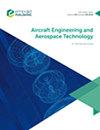无人机气动装置设计——经验教训
IF 1.2
4区 工程技术
Q3 ENGINEERING, AEROSPACE
引用次数: 0
摘要
设计最先进的新飞机总是需要新技术的发展。本文旨在介绍在设计、建造和测试飞翼配置的新型无人机时所吸取的经验教训。该无人机包含了许多气动装置,这些装置不是明显的解决方案,并且使用了最新的制造技术成果,例如3D打印。设计/方法/方法设计方案应用于一架适航飞机,并在试飞期间进行了检查。该过程首先在较小的UAV上进行,并且基于测试结果,进行改进,然后应用在较大版本的UAV上,在那里它们被验证。确定了一些实际的发现。例如,利用3D打印技术制造集成压力口,研究偏航对飞翼构型的不利影响以及小翼舵在产生偏航力矩方面的有效性。所有设计的装置都在飞行飞机上进行了实际测试。它允许改进飞机性能和操作特性。使用的一些技术提高了气动装置设计和制造的速度和质量,这也影响了飞机的可靠性。本文介绍了如何利用3D打印技术制造气动装置。特别开发的控制面设计技术,可以影响不利的偏航问题和飞机的操纵特性,描述。本文章由计算机程序翻译,如有差异,请以英文原文为准。
Designing aerodynamic devices for UAV – lessons learned
Purpose Designing new aircraft that are state-of-the-art and beyond always requires the development of new technologies. This paper aims to present lessons learned while designing, building and testing new UAVs in the configuration of the flying wing. The UAV contains a number of aerodynamic devices that are not obvious solutions and use the latest manufacturing technology achievements, such as 3D printing. Design/methodology/approach The design solutions were applied on an airworthy aircraft and checked during test flights. The process was first conducted on the smaller UAV, and based on the test outcomes, improvements were made and then applied on the larger version of the UAV, where they were verified. Findings A number of practical findings were identified. For example, the use of 3D printing technology for manufacturing integrated pressure ports, investigation of the adverse yaw effect on the flying wing configuration and the effectiveness of winglet rudders in producing yawing moment. Practical implications All designed devices were tested in practice on the flying aircraft. It allowed for improved aircraft performance and handling characteristics. Several of the technologies used improved the speed and quality of aerodynamic device design and manufacturing, which also influences the reliability of the aircraft. Originality/value The paper presents how 3D printing technology can be utilized for manufacturing of aerodynamic devices. Specially developed techniques for control surface design, which can affect adverse yaw problem and aircraft handling characteristics, were described.
求助全文
通过发布文献求助,成功后即可免费获取论文全文。
去求助
来源期刊
CiteScore
3.20
自引率
13.30%
发文量
168
审稿时长
8 months
期刊介绍:
Aircraft Engineering and Aerospace Technology provides a broad coverage of the materials and techniques employed in the aircraft and aerospace industry. Its international perspectives allow readers to keep up to date with current thinking and developments in critical areas such as coping with increasingly overcrowded airways, the development of new materials, recent breakthroughs in navigation technology - and more.

 求助内容:
求助内容: 应助结果提醒方式:
应助结果提醒方式:


